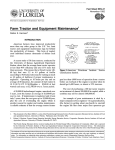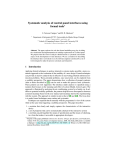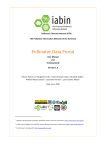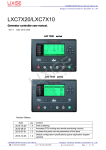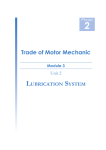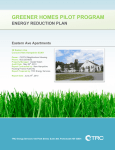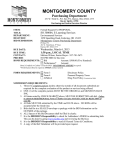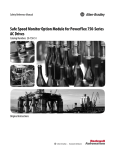Download Farm Tractor and Equipment Maintenance
Transcript
Fact Sheet EES-47 November 1992 Farm Tractor and Equipment Maintenance1 Dalton S. Harrison2 INTRODUCTION American farmers have improved productivity more than any other group in the U.S. Yet, farm tractor and equipment maintenance lags far behind the productivity of farmers. This form of neglect costs individual farmers thousands of dollars each year. A recent study of 50 farm tractors, conducted by the University of Kansas Agricultural Experiment Station, shows that the average farm tractor operates at less than 90% efficiency and uses 15% more fuel than necessary. This means that a Diesel tractor (40-60 hp) that uses 3.2 to 4.9 gallons of fuel/hr (according to Nebraska tests) may be wasting as much as 3/4 gallon of fuel/hour if proper maintenance is neglected. Operating at 10 hours per day and an average of 80 days/year, the amount of fuel wasted is 10 X 80 X 0.75 X $0.90/gallon = $540.00 of fuel wasted each year, or $2,700.00 over a 5year period. A $9,000.00 turbocharged engine, amortized over 5 years, costs the farmer an average of $1,800.00 per year to own. If maintenance is neglected and it lasts only 3 years, then the cost goes up to $3,000.00/year, plus the cost of overhauling the engine which is another reason for regular and routine maintenance. A reliable estimate is that the average tractor farmer gets less than 4,000 hours of operation from a tractor before an overhaul of Figure 1.American Petroleum Classification Symbol. Institute Service the engine is needed, when he should get 6,400 hours, or almost a 52% increase. The cost of purchasing a 100 hp tractor requires an investment of almost $50,000.00 in capital, while a combine may sell for almost $100,000.00. An example of poor maintenance is cited by a major company service engineer: "As a generalization, (the farmer) is getting about one-fourth to one-half the engine 1. This document is Fact Sheet EES-47, a series of the Florida Energy Extension Service, Florida Cooperative Extension Service, Institute of Food and Agricultural Sciences, University of Florida. Publication date: November 1992. 2. Dalton S. Harrison, Former Energy Extension Specialist, Energy Extension Service, Cooperative Extension Service, Institute of Food and Agricultural Sciences, University of Florida, Gainesville FL 32611. The Florida Energy Extension Service receives funding from the Florida Energy Office, Department of Community Affairs and is operated by the University of Florida’s Institute of Food and Agricultural Sciences through the Cooperative Extension Service. The information contained herein is the product of the Florida Energy Extension Service and does not necessarily reflect the views of the Florida Energy Office. The Institute of Food and Agricultural Sciences is an equal opportunity/affirmative action employer authorized to provide research, educational information and other services only to individuals and institutions that function without regard to race, color, sex, age, handicap, or national origin. For information on obtaining other extension publications, contact your county Cooperative Extension Service office. Florida Cooperative Extension Service / Institute of Food and Agricultural Sciences / University of Florida / Christine Taylor Stephens, Dean Farm Tractor and Equipment Maintenance Page 2 life that1.some fleet aoperators getfilter. from engines. Table Stepsmajor in servicing dry-type air Always have engine turned off when servicing the air fitter. Before removing top cover, wipe it off. Caution: Do not change in unprotected place as dust is likely to blow in. Extreme care should be taken to prevent dust from falling into the clean air space or outlet of the filter while removing fasteners and holders. Many air fitter problems are actually caused by dirt falling into the filter while servicing. Remove cover and inspect cover gasket. Replace this gasket at least once a year, more often if needed. Caution: Warped and dented covers will not seal properly and must be replaced. Lift out element carefully to prevent dirt from falling into the engine pipe. Caution: Do not pry old element from filter housing. This could cause distortion and permit unfiltered air to enter the engine. Warm parts to ease separation in cold weather. Use a clean, moist cloth to wipe up any dirt in the filter housing. Caution: Put outer cover over opening to guard against dust entry. (Do not use air hose to clean finer housing as this will blow dirt into engine.) If the pre-cleaner consists of tubes, clean with a stiff brush, compressed air or water. Caution: Dry thoroughly before returning to service. Inspect all gaskets and replace those which are worn or damaged. Here are the usual gasket locations: outer cover, inner cover, filter retention washer, filter body and dust cup. Caution: Re-installing worn or damaged gaskets, particularly on bolt, is one of the biggest causes of air filter failure. The air filter can’t work if the gasket lets air bypass the filter. Re-assemble in reverse order of disassembly. If the lid has bolts, tighten uniformly by criss-cross tightening. Clamps and mounting bands should be uniformly tightened also. Caution: Make sure dust cup fits airtight. Inspect and tighten all air cleaner induction system connections. (Replace cracked rubber connectors.) Caution: Watch for unusual amount of dirt gathering at a connector This could mean a leak. The major difference is that the farmer often neglects an engine while the fleet operator has a rigid schedule for maintenance and care." A tractor pulling a hay wagon and idling at less than half the slow idling speed causes scarred cylinder walls. Unfortunately the tractor driver assumed he was saving money on fuel when in fact the tractor was not getting proper lubrication. Reading the operator’s manual and knowing the correct gear-speedratio could have prevented this needless repair. MAINTENANCE SUGGESTIONS Oil, Lubrication Systems Oil reduces wear, cuts friction, absorbs shocks, cushions loads, seals between cylinder wall and piston rings, cools, prevents bearing corrosion, provides rust protection, and neutralizes and cleans working surfaces. Oil considered to be of high quality only a few years ago will not give good service in today’s high performance engines which run hotter, at higher rpms, and have closer tolerance (Table 2). One fact is certain: you do not save money by buying cheap oil and you do not save money by trying to squeeze extra life out of oil. Important Considerations Select the product based on your equipment manufacturer’s recommendation. As major filter companies recommend, select the oil based on the API (American Petroleum Institute) Service classification symbol. There are 3 items or parts to look for: (a) Performance quality - at the top of the symbol; (b) Viscosity - at the center of the symbol; and (c) If Fuel-Saving properties demonstrated - at the bottom of the symbol (Figure 1 and Table 2). Other factors to look for when purchasing the right oil are additives, oxidation inhibitors, foam inhibitors, rust corrosion and antiwear additives, pour point depressants, viscosity index improvers, and detergents and dispersants. Remember that good oil darkens quickly after it is put in use because of its detergent and dispersant action. Consult a further, well defined, engine service classification for engine oils (Table 3). Farm Tractor and Equipment Maintenance Page 3 Table 2. Guide to SAE* Viscosity. Typical Recommendation Lowest Air Single Viscosity Multi-Viscosity 32 F 20, 2OW, 30 1OW-30, 1OW-40, 1OW-50,15W-40, 2OW-40, 3OW-50 OF 10W 1OW-30, 1OW-40 Below 0 F 5W** 5W-20**, 5W-30, 5W-40 NOTE: Single grade oil generally not recommended for cold weather * Society of Automotive Engineers ** 5W and SW-20 NOT suitable for sustained high-speed driving. See your owner’s manual for specifics. Follow Manufacturer’s Recommendation for Specific Model Weight or ability to resist thinning is measured in SAE ’grade’ numbers. Plan Adequate Lubrication for Irrigation Engines Adequate lubrication at regular intervals is a necessity. Running an irrigation engine is like puffing 1,000 to 1,200 miles on your car each day, day after day. Proper filtration can prevent costly repairs and help avoid breakdowns at critical times when irrigation is badly needed. There is also a growing trend toward the addition of extended-life by-pass filters attached to lubrication systems that formerly had only full-flow filters. The way to make sure that the addition of a by-pass filter does all that you want it to do is to install a B-7500 housing. The filter is available with the extra-long life P-7500 filter element for double dirt-trapping ability and extra protection. These filters are available in both 750 cu. in. and 500 cu. in. * Figure 2.By-Pass Filter System. trapping contaminants much smaller than those trapped by a full flow system (Figure 3). A full-flow filter usually filters out 25-micron-sized contaminants. A human hair is about 40 microns in diameter. The Baldwin P-7500 filters out 3-micron-sized contaminants, or about 3/39 millionths of an inch. The best filtration may be provided when both filters are used on the same engine. Hydraulic and Transmission Systems Manufacturers suggest checking the hydraulic fluid level every 10, 50 to 250 hours. It can be checked every time the regular oil level is checked because most systems have either a sight glass or a dip stick. Fill the systems as needed but never over-fill them. Do not ever extend the oil and filter change period beyond one year. Fuel Storage and Avoiding Moisture In a full-flow system, all the oil passes through the filter before being sent on to lubricate the bearings and moving parts (Figure 3). This means that the full-flow filter cannot possibly remove contaminants as small as those removed with a by-pass filter. Because most of Florida’s small farmers have changed to diesel tractors and power units, the proper care and maintenance of fuel storage tanks also is vital to saving energy, dollars, and needless repairs. Three phases tell the whole story: (1) purchase clean fuel, (2) keep it clean, and (3) keep it free of water. A by-pass filter system (Figure 2) continuously filters a portion of the oil while the engine is operating (Figure 3). This filtered oil is returned to the crank case where the by-pass filter prefilters the oil to take much of the load off the full-flow filter. The oil then flows through the by-pass system much more slowly while Because less than one ten-thousandth of an inch separates moving parts of some diesel fuel injection engines, one can imagine that it doesn’t take much abrasive material or water to be harmful to parts with this small amount of clearance. Farm Tractor and Equipment Maintenance Page 4 Table 3. API* engine service classification for oil. "S" for Gasoline Engines Cars and Light Trucks "C" for Diesel Engines Commercial and Farm Equipment (NOTE CA, CB and CC also used on some gasoline engines) SA and SB - Obsolete classifications denoting oil which is inadequate for today’s engines. Do not use unless specifically recommended by the equipment manufacturer. (SA could be used for oiling electric motor bearing because additives are NOT desirable in this case.) CA - Mild Service. Used in very old engines burning high quality (low-sulfur) fuels. Do Not use on modern engines. SC - Controls high- and low- temperature deposits. Has wear-, rust and corrosion-resistance specified by car (and some truck engine) makers 1964-67. CB - Mild to moderate duty. Primarily used before 1965. Do not use on today’s engines unless specifically recommended by the equipment manufacturer. SD - Can be used to replace SC. Provides additional protection against high- and low-temperature engine deposits, wear, rust and corrosion. Specified for 196870 (some 71 and later) cars and some trucks. CC - Moderate to severe duty. Introduced in 1961. Protects against high-temperature deposits and bearing corrosion in diesel engines. Also resists rusts, corrosion and sludge in low-temperature operation of commercial gas engines. SE - Used in emission-controlled engines 1971-79. Can also be used where SC or SD is specified. CD - Severe duty. Introduced in 1955 to provide protection from bearing corrosion and high temperature deposits. Used on severe duty naturally aspirated, turbocharged or supercharged diesel engines or when fuels with high sulfur contents are used. Can also be used where CA, CB or CC is prescribed. SF - Provides increased oxidation stability and antiwear performance. Used in 1980 on cars and some trucks. Can also be used where SC, SD or SE is specified. CE - Turbocharged/supercharged heavy duty service. Introduced in 1987 for engines manufactured since 1983 operated under high-load condition whether at low- or high-speeds. Can also be used to replace any of the above classifications. NOTE: Use oil with service classification specified in service manual or a universal oil. If the diesel fuel you use has a high sulfur content, it is necessary to use a grade oil containing more detergency or greater neutralizing ability, such as one meeting API service category CD, C E, SF/CD or SF/CE. * API - American Petroleum Institute Much of the contamination of diesel fuel comes in storage after delivery. Some of the items that cause contamination are rust and bits of worn hose, evaporation causing gum to form which clogs fuel lines, and water rusting inside the tank, which can damage the fuel injection systems on diesel engines. Always fill the fuel tank at the end of the day to avoid air and moisture problems. When air is present in the tank overnight, it cools and permits moisture from the air to run down into the fuel. In below-ground storage tanks, the tank should be tilted and the drain at the lower end to permit pumping out the excess water and debris, while the upper end of the tank should be provided with the filler pump for filling the tractor or other equipment. The suction pipe should be several inches higher than the bottom of the tank. Adding a filter to the pumping line of the storage tank can also be an added benefit. Also, a bleed plug on the filter housing will rid the system of entrapped air. SUMMARY Remember that tractor and equipment maintenance can help to conserve energy and prevent needless repairs, but it is impossible to cover all the "tips’, such as servicing filters, belts, hoses, or hydraulic systems. Farm Tractor and Equipment Maintenance Page 5 A manufacturer’s operating and maintenance manual should be read and followed carefully for each type of equipment that is operated. Figure 3.A Full-Flow Filter System. REFERENCES Baldwin Filters. 1988. Farm Equipment Maintenance and Filter Guide. Cromwell, R.R 1977. Selecting Power Equipment to Save Energy EC-19, Florida Cooperative Extension Service, IFAS, University of Florida. Cromwell, R. P. 1977. Tractor Operation for Fuel Savings. EC-21, Florida Cooperative Extension Service, IFAS, University of Florida. Cromwell, R.R 1980. Nebraska Tractor Test Results. Agricultural Engineering Extension Report 80-6, Florida Cooperative Extension Service, IFAS, University of Florida. It’s a Traders Market. 1988. Case-IH, J.1. Case, Racine, Wi.





